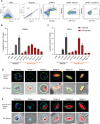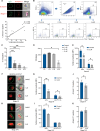Reversible host cell surface remodelling limits immune recognition and maximizes survival of Plasmodium falciparum gametocytes
- PMID: 40354414
- PMCID: PMC12091884
- DOI: 10.1371/journal.ppat.1013110
Reversible host cell surface remodelling limits immune recognition and maximizes survival of Plasmodium falciparum gametocytes
Abstract
Reducing malaria transmission has been a major pillar of control programmes and is considered crucial for achieving malaria elimination. Gametocytes, the transmissible forms of the P. falciparum parasite, arise during the blood stage of the parasite and develop through 5 morphologically distinct stages. Immature gametocytes (stage I-IV) sequester and develop in the extravascular niche of the bone marrow and possibly spleen. Only mature stage V gametocytes re-enter peripheral circulation to be taken up by mosquitoes for successful onward transmission. We have recently shown that immature, but not mature gametocytes are targets of host immune responses and identified putative target surface antigens. We hypothesize that these antigens play a role in gametocyte sequestration and contribute to acquired transmission-reducing immunity. Here we demonstrate that surface antigen expression, serum reactivity by human IgG, and opsonic phagocytosis by macrophages all show similar dynamics during gametocyte maturation, i.e., peaking in the immature stages and tapering off in mature gametocytes. Moreover, the switch in surface reactivity coincides with reversal in phosphatidylserine (PS) surface exposure, a marker for red blood cell age and clearance. PS is exposed on the surface of a proportion of immature gametocyte-infected RBCs (as well as in late asexual stages) but is removed from the surface in later gametocyte stages (IV-V). Using parasite reverse genetics and drug perturbations, we confirm that parasite protein export into the host cell and phospholipid scramblase activity are required for the observed surface modifications in asexual and sexual P. falciparum stages. Based on these findings we propose that the reversible surface remodelling allows (i) immature gametocyte sequestration in bone marrow followed by (ii) mature gametocyte release into peripheral circulation (and immune evasion due to loss of surface antigens), therefore contributing to mature gametocyte survival in vivo and onward transmission to mosquitoes. Importantly, blocking scramblase activity during gametocyte maturation results in efficient clearance of mature gametocytes, revealing a potential path for transmission blocking interventions. Our studies have important implications for our understanding of parasite biology and form a starting point for novel intervention strategies to simultaneously reduce parasite burden and transmission.
Copyright: © 2025 Ngotho et al. This is an open access article distributed under the terms of the Creative Commons Attribution License, which permits unrestricted use, distribution, and reproduction in any medium, provided the original author and source are credited.
Conflict of interest statement
The authors have declared that no competing interests exist.
Figures






Update of
-
Reversible host cell surface remodelling limits immune recognition and maximizes transmission of Plasmodium falciparum gametocytes.bioRxiv [Preprint]. 2024 Apr 30:2024.04.30.591837. doi: 10.1101/2024.04.30.591837. bioRxiv. 2024. Update in: PLoS Pathog. 2025 May 12;21(5):e1013110. doi: 10.1371/journal.ppat.1013110. PMID: 38746342 Free PMC article. Updated. Preprint.
Similar articles
-
Reversible host cell surface remodelling limits immune recognition and maximizes transmission of Plasmodium falciparum gametocytes.bioRxiv [Preprint]. 2024 Apr 30:2024.04.30.591837. doi: 10.1101/2024.04.30.591837. bioRxiv. 2024. Update in: PLoS Pathog. 2025 May 12;21(5):e1013110. doi: 10.1371/journal.ppat.1013110. PMID: 38746342 Free PMC article. Updated. Preprint.
-
Naturally acquired immunity against immature Plasmodium falciparum gametocytes.Sci Transl Med. 2019 Jun 5;11(495):eaav3963. doi: 10.1126/scitranslmed.aav3963. Sci Transl Med. 2019. PMID: 31167926 Free PMC article.
-
Primaquine for reducing Plasmodium falciparum transmission.Cochrane Database Syst Rev. 2012 Sep 12;(9):CD008152. doi: 10.1002/14651858.CD008152.pub2. Cochrane Database Syst Rev. 2012. Update in: Cochrane Database Syst Rev. 2014 Jun 30;(6):CD008152. doi: 10.1002/14651858.CD008152.pub3. PMID: 22972117 Updated.
-
Primaquine or other 8-aminoquinoline for reducing Plasmodium falciparum transmission.Cochrane Database Syst Rev. 2015 Feb 19;(2):CD008152. doi: 10.1002/14651858.CD008152.pub4. Cochrane Database Syst Rev. 2015. Update in: Cochrane Database Syst Rev. 2018 Feb 02;2:CD008152. doi: 10.1002/14651858.CD008152.pub5. PMID: 25693791 Free PMC article. Updated.
-
Primaquine or other 8-aminoquinolines for reducing Plasmodium falciparum transmission.Cochrane Database Syst Rev. 2018 Feb 2;2(2):CD008152. doi: 10.1002/14651858.CD008152.pub5. Cochrane Database Syst Rev. 2018. PMID: 29393511 Free PMC article.
References
-
- WHO. World malaria report 2021. 2021. PubMed .
MeSH terms
Substances
Grants and funding
LinkOut - more resources
Full Text Sources

